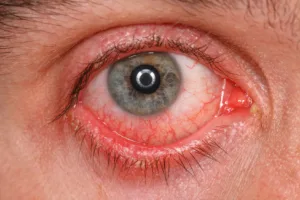
Understanding Conjunctivitis in Eyes: Causes, Symptoms, and Treatment
Introduction
Welcome to another informative blog on ‘Conjunctivitis in Eyes’ by Dr Ashesh Gala, a senior Ophthalmologist practising at Netrajyot Eye Care Centre in Mulund, Mumbai.
Today, we delve into the fascinating topic of conjunctivitis, a common eye condition that affects people of all ages.
If you’ve ever wondered what conjunctivitis is, how it manifests in the eyes, its symptoms, and treatment options, you’re in the right place.
Let’s explore the world of conjunctivitis together!
1. What is Conjunctivitis in Eyes and How Does it Affect the Eyes?
Conjunctivitis, also known as pink eye, is an inflammation of the conjunctiva.
It is a thin and transparent layer of tissue that covers the white part of the eye and lines the inner surface of the eyelids.
When this delicate layer becomes inflamed, it causes discomfort, redness, and sometimes a gritty sensation.
2. Conjunctivitis in Eyes Symptoms: How to Recognize Pink Eye?
Recognizing the symptoms of conjunctivitis is crucial for timely treatment.
Here are some common signs to look out for:
Redness: The whites of the eyes appear pink or reddish.
Itching and Irritation: The affected eyes may feel itchy, and rubbing can worsen the condition.
Watery Discharge: Conjunctivitis often causes excessive tearing, leading to a watery discharge.
Gritty Sensation: You might experience a feeling of having sand or grit in your eyes.
Swelling: The eyelids can become puffy or swollen, making it uncomfortable to open or close the eyes.
Light Sensitivity: Conjunctivitis can cause increased sensitivity to light, making bright environments uncomfortable.
3. Types of Conjunctivitis in Eyes and Their Causes
Conjunctivitis can be caused by various factors, including viruses, bacteria, allergens, and irritants.
Let’s explore the different types and their causes:

Viral Conjunctivitis: This type is highly contagious and is often associated with the common cold or respiratory infections.
It spreads quickly through direct contact with infected individuals or contaminated surfaces.

Bacterial Conjunctivitis: Caused by bacteria such as Staphylococcus aureus or Streptococcus pneumoniae.
This form of conjunctivitis is also contagious and can spread through direct contact.

Allergic Conjunctivitis: Allergens such as pollen, pet dander, or dust mites can trigger an allergic reaction in susceptible individuals, leading to conjunctivitis.
It is not contagious.
Irritant Conjunctivitis: Exposure to irritants like smoke, chemicals, or foreign bodies can cause irritation and redness of the conjunctiva.
This type is also not contagious.

4. Conjunctivitis in Eyes Treatment: How to Relieve the Symptoms?
The treatment for conjunctivitis depends on its underlying cause. Here are some common approaches:
Viral Conjunctivitis:
Since viral infections have no specific cure, treatment focuses on symptom relief.
Applying cool compresses and using lubricating eye drops can alleviate discomfort.
It’s important to practice good hygiene, such as frequent handwashing, to prevent the spread of the virus.
Bacterial Conjunctivitis:
Antibiotic eye drops or ointments are typically prescribed to treat bacterial conjunctivitis.
It’s essential to complete the full course of antibiotics as prescribed by your ophthalmologist to prevent the infection from recurring.
Allergic Conjunctivitis:
Avoiding allergens is key to managing allergic conjunctivitis.
However, when exposure to allergens is unavoidable, your doctor may recommend the following:

Antihistamine eye drops or oral medications: This help reduces allergic reactions and relieves symptoms like itching and redness.

Cold compresses: Applying a cold compress or cool, damp cloth to the eyes can help soothe irritation and reduce swelling.
Artificial tears: Lubricating eye drops can provide temporary relief by moisturizing the eyes and flushing out allergens.

Irritant Conjunctivitis: The primary approach for irritant conjunctivitis is to remove or avoid the irritant causing the inflammation.
Flushing the eyes with clean water or saline solution can help wash away any foreign substances.
5. Bacterial Conjunctivitis Treatment
When it comes to treating bacterial conjunctivitis specifically, it’s important to target the underlying bacterial infection.
Here’s what you need to know:
Antibiotic eye drops or ointments: These medications are prescribed to eliminate the bacteria causing the infection.
It’s crucial to follow your ophthalmologist’s instructions regarding the dosage and duration of treatment.
Applying the prescribed medication correctly helps ensure the bacteria are fully eradicated.
Good hygiene practices: To prevent the spread of bacterial conjunctivitis, it’s vital to maintain good hygiene.
Wash your hands frequently, especially before touching your eyes or applying eye drops.
Avoid sharing towels, pillows, or other personal items with infected individuals.
6. How Does Conjunctivitis Spread?
Understanding how conjunctivitis spreads is essential in preventing its transmission.
Let’s explore the modes of transmission for different types of conjunctivitis:
Viral Conjunctivitis: This form of conjunctivitis is highly contagious. It spreads quickly through direct contact with infected individuals or contaminated surfaces.
Sharing personal items such as towels, handkerchiefs, or makeup can also facilitate the spread.
Bacterial Conjunctivitis: Similar to viral conjunctivitis, bacterial conjunctivitis is contagious and spreads through direct contact.
Touching infected eye secretions and then touching your own eyes can lead to transmission.
Allergic Conjunctivitis: Unlike viral and bacterial conjunctivitis, allergic conjunctivitis is not contagious.
It occurs as a result of the body’s immune response to allergens. It is not spread through person-to-person contact.
7. How Long Does Conjunctivitis Last ?
The duration of conjunctivitis varies depending on its underlying cause and the effectiveness of treatment. Here’s a general overview:
Viral Conjunctivitis: The duration of viral conjunctivitis can range from a few days to a few weeks. Symptoms tend to improve gradually as the body fights off the viral infection.
Bacterial Conjunctivitis: With appropriate treatment, bacterial conjunctivitis usually improves within a week. It’s essential to complete the full course of antibiotics to prevent a recurrence.
Allergic Conjunctivitis: Allergic conjunctivitis can last as long as the allergen is present or until effective management strategies are implemented.
Avoiding allergens and using prescribed medications can help control symptoms.
Irritant Conjunctivitis: Once the irritant is removed or avoided, irritant conjunctivitis typically resolves within a short period.

Empowering Yourself with Knowledge
Understanding conjunctivitis, its symptoms, and treatment options is vital in managing this common eye condition.
By familiarizing yourself with the causes and modes of transmission, you can take
proactive steps to prevent the spread of conjunctivitis and protect yourself and others. Here are a few key takeaways:

Practice good hygiene: Wash your hands frequently with soap and water, especially before touching your eyes or applying any eye drops. Avoid touching or rubbing your eyes, as this can increase the risk of infection.

Avoid sharing personal items: Refrain from sharing towels, handkerchiefs, pillowcases, or makeup with others, as these items can harbour infectious agents and contribute to the spread of conjunctivitis.

Follow treatment guidelines: If you’ve been diagnosed with conjunctivitis, adhere to the prescribed treatment plan. Whether it involves using antibiotic eye drops, taking oral medications, or implementing allergy management strategies, consistent and proper treatment can help speed up recovery and prevent complications.

Take preventive measures: If someone in your household or close circle has conjunctivitis, take precautionary measures to minimize the risk of transmission. Avoid close contact, wash your hands frequently, and disinfect commonly touched surfaces to reduce the chances of contracting the infection.

A Call to Action: Prioritize Your Eye Health
Now that you’ve gained valuable insights into conjunctivitis, it’s time to prioritize your eye health. If you experience any symptoms like redness, itching, or discomfort in your eyes, don’t hesitate to consult a qualified eye care professional like Dr Ashesh Gala at Netrajyot Eye Care Centre.
Remember, early diagnosis and prompt treatment can make a significant difference in managing conjunctivitis effectively. By seeking professional help, you can receive personalized care, accurate diagnosis, and tailored treatment options to alleviate your symptoms and prevent complications.
Conclusion
In conclusion, conjunctivitis, or pink eye, is a common eye condition that can affect individuals of all ages. Whether it’s viral, bacterial, allergic, or irritant conjunctivitis, understanding the causes, symptoms, and appropriate treatment is crucial for your eye health and the well-being of those around you.
By staying informed, practising good hygiene, following treatment guidelines, and taking preventive measures, you can minimize the impact of conjunctivitis and protect your eyes and the eyes of your loved ones.
Have you ever experienced conjunctivitis or known someone who has? Share your experiences, questions, or thoughts in the comments below!
Let’s create a community dedicated to eye health and well-being.

